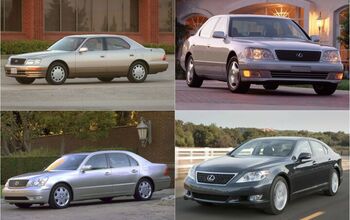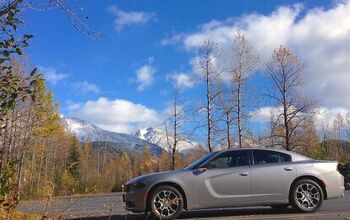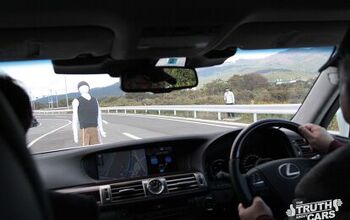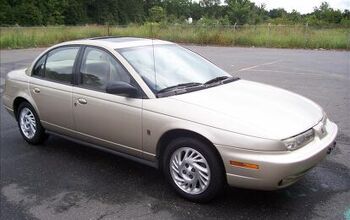Ask Jack: A Man For All-Seasons?

Talk about being careful what you wish for. I now have about 40 questions in my inbox for “Ask Jack,” with more steadily trickling in. I’m going to answer all of them, either here or via e-mail, and in a semi-timely manner to boot. So don’t be afraid to send your questions to askjack@jackbaruth.com. I’m ready, and waiting, to give you the kind of bad advice you can only get from somebody who’s crashed more marriages than he has crashed race cars!
Robert writes:
Hi Jack. In keeping with the mantra, “Want to be a better driver? Get a worse tire,” I do indeed want to be a better driver. Specifically, a better autocross driver. I’ve run the original equipment, 600-treadwear tires on my ’14 Honda Civic Si for my first four events. I suck, but I’m steadily improving with every event. I can get one, maybe two more events out of these tires before they’re down past the tread-wear markers. All the instructors I’ve driven with say the same thing: get Potenza RE71s because the tires I have are costing me 2 to 5 seconds. That gap would have gotten me on the podium at the last two events. But I know I’m still leaving seconds out there due to my inexperience. Should I go Potenza when I replace the tires?
This is the sort of question I love to get — thoughtful, easy to understand, and right in the proverbial wheel house. Even better, the answer to the question will be useful to many of you, even if you have no idea what an “autocross” might be.
Let’s start by looking at that phrase. Want to be a better driver? Get a worse tire. Here’s what that means. You can’t learn to control a car at the limit without actually, you know, driving up to that limit and seeing what happens. Let’s briefly compare two theoretical drivers. Driver A has an old RWD Toyota Tercel on 155-width all-season tires. Driver B is behind the wheel of a brand-new Dodge Viper ACR. Neither of them has any performance-driving experience, but are determined to learn, so we are going to take them to a racetrack and set them free to drive until they’ve learned something.
Driver A is going to reach the limits of the Tercel pretty quickly. He might spin into the gravel at 30 mph a few times. At the end of the day, he’ll be reasonably good at driving that Tercel near the limit of its tires and chassis. If we gave him a slightly better car on Day Two of the exercise, he would learn the difference in capability in — we hope — a reasonable and safe manner. And we could give him a slightly better car every day after that, until one day he was behind the wheel of a Dodge Viper ACR, driving it easily at the limit because he has advanced to that limit in small, comprehensible steps. Incidentally, this is basically the path your humble author has followed, starting with some real shitboxes and moving up to stuff like the McLaren MP4-12C-GT3 full-on Pirelli World Challenge GT car.
Driver B will spend a lot of his first day not coming anywhere close to the limits of that Viper ACR. But the first time that he exceeds the limit, he’ll be going very fast and he’s not going to have the skills to handle the situation. Chances are he is going to destroy the car and maybe even get hurt. Under no circumstances will he magically become a top-notch Viper ACR driver. This, by the way, is the path your humble author followed with motorcycles. The first streetbike I ever rode was a Kawasaki ZX-7R. I was lucky to escape that enlightening experience with my limbs intact.
In the real world, of course, very few people have the choice between a ’79 Tercel and a Viper ACR. But they do face choices like the one that Robert is currently facing. He did the right thing by starting on relatively slippery tires. He’s learned a lot about controlling his car when it is past the limits of grip, and so far he hasn’t rolled the thing or even dented a fender. Now he’d like to start contending for trophies, which means he’s thinking about serious rubber. Should he do it?
There are three potential answers to this question, and it depends on what he’s going to do with the car. As an autocrosser, Robert is unlikely to put himself in harm’s way with the “Hoosier-Stone” Potenzas. And it sounds like he’s already learned how to handle the car pretty well. So my answer to him is simple: get the good tires and start fighting for podiums.
But what if Robert wasn’t an autocrosser, but instead was a casual trackday enthusiast with four or five events under his belt? Should he go directly to the grippiest street tires available? In that case, I would say that he should not get the Bridgestones right away. Instead, he should choose a midpoint tire like the Cooper RS-G1 or Yokohama Advan Sport. Once he’s killed those with five or six more events, he can think about the Bridgestones. With trackday driving, we move the performance bar more slowly because the stakes for making a mistake are much higher. Don’t be in any hurry to get a faster car, or faster equipment for your existing car, until you know that you are really running what you have right up to the ragged edge.
The last scenario: Maybe Robert doesn’t compete at all. Maybe he just wants to enjoy the car on the street. In that case, I’m going to make precisely the opposite recommendation. Go directly to the Potenzas, but drive below the limit of the car and be careful when you are going fast. On the street, we want all the safety margin we can get, even if it is at the expense of “tossability.” When the day comes that an SUV in front of us flips over and starts tumbling across the freeway in our direction, we’ll want the absolute maximum grip possible. It might save your live.
If you spend any time at a racetrack, you’ll see that a lot of Miata racers have high-power street cars. I’ve seen everything from a Boss 302 to a Lamborghini Huracan in the Spec Miata paddock. Those drivers are learning how to control their Mazdas at the absolute limit. Then they’re giving themselves a lot more grip and capability for the street. I don’t disagree with that philosophy at all — if you can afford it, that is. The rest of us will just have to be content with putting Potenzas on our Civics and hustling for that local podium.
Good luck, Robert, and may the ‘Stone be with you!
[Image: © 2016 Bozi Tatarevic/The Truth About Cars]

More by Jack Baruth
Latest Car Reviews
Read moreLatest Product Reviews
Read moreRecent Comments
- Wjtinfwb No confusion on my end, Ghost. The Government has zero role in job creation outside of the legitimate opportunities' created by Government going about it's responsibilities, namely keeping the American people and territory safe from foreign intrusion. Of course, they're failing epically at that but that's a different topic. The American free enterprise system is what enables job creation. Government's role is to stay out of the way of that system, but they seem incapable of doing so. Oil & Gas exploration is just one example. If a National Job Policy is what you're looking for, there are other countries that will be happy to accept your application for residency.
- Michael Smith I drive 100-300 miles a day in new BMWs, Mercedes-Benzes, and GM SUVs. Some are already equipped with automatic braking.It's the first thing I turn off when I start the car.I've had experiences where (as the author notes) the system gave false alarms and stabbed the brake pedal, threatening my ability to control the car.Further, every driver encounters situations where, for example, legal following distance must be momentarily compromised in order to avoid a difficult situation. When the system intervenes, it disrupts the driver's plan of action. This can lead to a collision as the driver has to suddenly react not to his surroundings, but to the system.Not only is automatic braking an insult to skilled drivers, it's dangerous to everyone.
- Dave M. My hipster daughter is greatly into it. We watched the race together this weekend. It was interesting but I'm not devoted to it like she is. She'll be at the Austin race in October.
- Bd2 I'll watch F1 when Kia and/or Hyundai pony (pun intended) up the cash to field a class leading team. Hyundai is leading many series with the Elantra N with it's incredible 350HP Smartstream-R engine.
- Steve Biro There are 24 races on this year’s F1 schedule. And I guarantee you no more than two will be reasonably exciting, Meanwhile, F1’s reception for Andretti reveals the dark underbelly of the sport. I have followed F1 since the 1960s and, frankly, I am running out of interest. I’ll catch a race if it’s convenient but won’t bother DVRing them.


































Comments
Join the conversation
One season, 3 or 4 friends and I shared autocrossing an old RWD Toyota Celica that we nicknamed "Slowleaka" because, you guessed it, it slowly leaked every fluid in the car. Not enough to drip on the course, but maybe a little in the paddock if we didn't slid a mat under it. We had cheap-sh!t all seasons on the car, and it wasn't terribly fast. We had a car that was a pig to drive, but we weren't afraid to push the car to 11/10ths. We learned a huge amount about car control that season, and had a great time doing it. And best of all, the four/five of us has a great time competing against each other, given our driving skill was the only thing setting us apart.
I've never had good tires, so I must be a great driver. I may have had a set of tires that weren't badly mis-matched in 1986, mounted to my 1974 Fiat 124 Spider. But it was a hot summer and they were short-lived. Cheap tires are why I can do four wheel drifts in town in the old Vette.